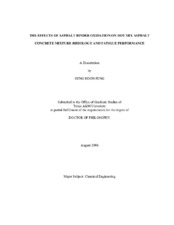| dc.contributor.advisor | Glover, Charles J. | |
| dc.creator | Jung, Sung Hoon | |
| dc.date.accessioned | 2010-01-15T00:15:29Z | |
| dc.date.accessioned | 2010-01-16T02:07:47Z | |
| dc.date.available | 2010-01-15T00:15:29Z | |
| dc.date.available | 2010-01-16T02:07:47Z | |
| dc.date.created | 2006-08 | |
| dc.date.issued | 2009-06-02 | |
| dc.identifier.uri | https://hdl.handle.net/1969.1/ETD-TAMU-1754 | |
| dc.description.abstract | Asphalt oxidation causes major changes to binder properties and is hypothesized
to be a major contributor to age-related pavement failure such as fatigue cracking.
Extensive laboratory aging research has been done to assess the effects of oxidation on
binder properties. Previous work shows binder oxidation makes the binder stiffer and
more brittle, leading to higher binder stresses under a given deformation. Failure occurs
when these stresses exceed the strength of the binder. However, binder oxidation in
pavements has not been studied in the same detail as laboratory aging of neat binders.
The impact of binder oxidation on long-term pavement performance has been either
underestimated or ignored.
This research includes studies of binder oxidation in Texas pavements to
compare the field aging with laboratory neat binder aging, the impact of binder oxidation
on HMAC mixture aging and HMAC mixture fatigue performance, and fundamental
rheological property changes of the binder and the mixture.
Binder oxidation is studied in fifteen pavements from locations across Texas.
Results indicate that unmodified binders in pavements typically oxidize and harden to a
degree that exceeds generally accepted pavement aging assumptions. This hardening
may also extend much deeper into the pavement than has been previously assumed or
documented. Data suggest that pavements can oxidize at rates surprisingly uniform with
depth once early oxidation occurs, and that these rates continue for an extended time.
Laboratory-aged HMAC mixtures and binders were tested and analyzed for
fatigue resistance and their rheological properties. Mixture aging shows the same aging mechanisms as neat binder aging. Both binder and mixture have a higher modulus with
aging and a good rheological correlation. The decline in mixture fatigue life (determined
using the calibrated mechanistic fatigue analysis approach with surface energy
measurement) due to oxidation is significant. Pavement service life is dependent on the
mixture, but can be estimated by a cumulative damage approach that considers binder
oxidation and pavement loading rate simultaneously. The differences in expected
pavement life arise from differences in the rate of binder stiffening due to oxidation and
the impact of this stiffening on the decline of fatigue life. | en |
| dc.format.medium | electronic | en |
| dc.format.mimetype | application/pdf | |
| dc.language.iso | en_US | |
| dc.subject | Binder Oxidation | en |
| dc.subject | HMAC Mixture Fatigue Performance | en |
| dc.title | The effects of asphalt binder oxidation on hot mix asphalt concrete mixture rheology and fatigue performance | en |
| dc.type | Book | en |
| dc.type | Thesis | en |
| thesis.degree.department | Chemical Engineering | en |
| thesis.degree.discipline | Chemical Engineering | en |
| thesis.degree.grantor | Texas A&M University | en |
| thesis.degree.name | Doctor of Philosophy | en |
| thesis.degree.level | Doctoral | en |
| dc.contributor.committeeMember | Davison, Richard R. | |
| dc.contributor.committeeMember | Mannan, M. Sam | |
| dc.contributor.committeeMember | Martin, Amy Epps | |
| dc.type.genre | Electronic Dissertation | en |
| dc.type.material | text | en |
| dc.format.digitalOrigin | born digital | en |


